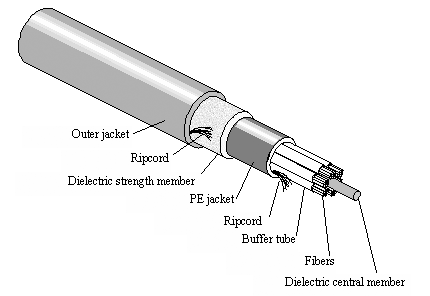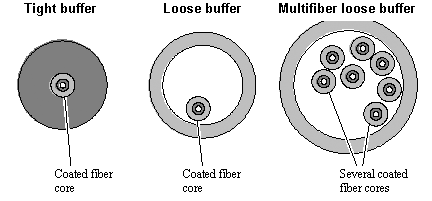Cabling the Fiber
Coated glass fibers are manufactured by a small handful of large, high-tech corporations. [90] The reeled fibers are then shipped to any of a much larger number of cable assembly plants located around the world where buffering and jacketing operations take place. The cable assembly plants then sell their fiber cables to distributors , who sell them to you.
[90] Lucent, Corning, and Siemans are prime examples.
If you need technical information about the optical properties of a fiber core, don't look to the distributor. Don't even look to the cable manufacturer. Find out who makes the core that interests you, and call directly to the core manufacturer. The optical properties of the fiber are determined almost entirely by the coated glass core . [91]
[91] Some optical properties are modified slightly by the heating and stretching that takes place during the buffer encapsulation process.
The mechanical properties of the cable, such as durability, weather-proofing, plenum-rating, pull strength, and bend radius are determined almost entirely by the buffer and jacket construction. This is what people at the cable assembly plant understand. If you cut open a lot of cables, you can learn about it too. When a cable is cut, you can count the fibers, you can see if the individual fibers are buffered, and you can see the various strength-enhancing features, such as nylon wraps, thick plastic jacketing, or metal sheathing (Figure 11.5). These cable features are all designed to protect the delicate nature of the fiber.
Figure 11.5. Cross section of all-dielectric, self-supporting, cable with 42 fibers.

When you think about it, a fiber core deserves quite a lot of protection. It's made of glass. It's 1/100 of an inch thick. An unprotected fiber stretched by as little as 1 part in 1,000 will break. A fiber subject to a series of small kinks, or microbends , suffers greatly increased attenuation.
A cable must endure the enormous forces exerted on the cable jacket when the cable is pulled, hung, or buried, without transmitting those forces to the internal fiber cores and without causing the fiber to kink.
There are two methods used to protect, or buffer, a fiber core [92] . The methods are the tight buffer and the loose buffer (Figure 11.6). The tight buffer method surrounds each coated fiber with a tight-fitting protective sleeve having a diameter (for 50 to 62.5 m m glass fiber) of 900 m m. A tight-buffer cable is easy to manufacture and works well for most horizontal in-building applications.
Figure 11.6. Various options for tight or loose buffering.

The loose buffer method surrounds each coated fiber with a loose-fitting tube or slot within which the fiber is free to move. The fibers inside a loose-buffered cable generally lie in some sort of helical spiral. A loose-buffered cable tends not to transmit external stretching and bending forces directly to the fibers and is therefore a good choice for tall vertical runs in high-rise buildings , or out-of-doors applications subject to large amounts of extrinsic stress. The interstitial spaces within a loose-buffered cable may be filled with a gooey gel to prevent the intrusion of water should the cable jacket be breached by animals, erosion , or mechanical forces.
Most desktop LAN cables incorporate an individual tight buffer on each fiber. Individual buffering enlarges the fibers to a workable size and provides a convenient way to color -code each fiber. Cables with individually buffered fibers are significantly easier to terminate in the field than are loose-buffered cables.. Unfortunately, individual buffering also enlarges the overall cable size, limiting the number of fibers that may be drawn through a conduit of fixed dimensions. In short-haul applications within a single campus, where ease of installation is the primary consideration, buffering of each individual fiber makes a lot of sense. In long-haul applications, where the density of fibers within a given conduit is the primary consideration, the fibers are jacketed in loose-buffered bundles.
All fiber core types are available in either tight-buffered or loose-buffered versions and with and without plenum-rated insulation. [92] As a digital system designer, you don't need to worry about what style of cable jacket is used in the field. Just specify the optical properties of the fiber core and let your installation people worry about the cable jacket.
[92] See Section 7.7, "Plenum-Rated Cables"
POINTS TO REMEMBER
- The optical properties of the fiber are determined almost entirely by the coated glass core.
- The mechanical properties of the cable are determined almost entirely by the buffer and jacket construction.
Fundamentals
- Impedance of Linear, Time-Invariant, Lumped-Element Circuits
- Power Ratios
- Rules of Scaling
- The Concept of Resonance
- Extra for Experts: Maximal Linear System Response to a Digital Input
Transmission Line Parameters
- Transmission Line Parameters
- Telegraphers Equations
- Derivation of Telegraphers Equations
- Ideal Transmission Line
- DC Resistance
- DC Conductance
- Skin Effect
- Skin-Effect Inductance
- Modeling Internal Impedance
- Concentric-Ring Skin-Effect Model
- Proximity Effect
- Surface Roughness
- Dielectric Effects
- Impedance in Series with the Return Path
- Slow-Wave Mode On-Chip
Performance Regions
- Performance Regions
- Signal Propagation Model
- Hierarchy of Regions
- Necessary Mathematics: Input Impedance and Transfer Function
- Lumped-Element Region
- RC Region
- LC Region (Constant-Loss Region)
- Skin-Effect Region
- Dielectric Loss Region
- Waveguide Dispersion Region
- Summary of Breakpoints Between Regions
- Equivalence Principle for Transmission Media
- Scaling Copper Transmission Media
- Scaling Multimode Fiber-Optic Cables
- Linear Equalization: Long Backplane Trace Example
- Adaptive Equalization: Accelerant Networks Transceiver
Frequency-Domain Modeling
- Frequency-Domain Modeling
- Going Nonlinear
- Approximations to the Fourier Transform
- Discrete Time Mapping
- Other Limitations of the FFT
- Normalizing the Output of an FFT Routine
- Useful Fourier Transform-Pairs
- Effect of Inadequate Sampling Rate
- Implementation of Frequency-Domain Simulation
- Embellishments
- Checking the Output of Your FFT Routine
Pcb (printed-circuit board) Traces
- Pcb (printed-circuit board) Traces
- Pcb Signal Propagation
- Limits to Attainable Distance
- Pcb Noise and Interference
- Pcb Connectors
- Modeling Vias
- The Future of On-Chip Interconnections
Differential Signaling
- Differential Signaling
- Single-Ended Circuits
- Two-Wire Circuits
- Differential Signaling
- Differential and Common-Mode Voltages and Currents
- Differential and Common-Mode Velocity
- Common-Mode Balance
- Common-Mode Range
- Differential to Common-Mode Conversion
- Differential Impedance
- Pcb Configurations
- Pcb Applications
- Intercabinet Applications
- LVDS Signaling
Generic Building-Cabling Standards
- Generic Building-Cabling Standards
- Generic Cabling Architecture
- SNR Budgeting
- Glossary of Cabling Terms
- Preferred Cable Combinations
- FAQ: Building-Cabling Practices
- Crossover Wiring
- Plenum-Rated Cables
- Laying Cables in an Uncooled Attic Space
- FAQ: Older Cable Types
100-Ohm Balanced Twisted-Pair Cabling
- 100-Ohm Balanced Twisted-Pair Cabling
- UTP Signal Propagation
- UTP Transmission Example: 10BASE-T
- UTP Noise and Interference
- UTP Connectors
- Issues with Screening
- Category-3 UTP at Elevated Temperature
150-Ohm STP-A Cabling
- 150-Ohm STP-A Cabling
- 150- W STP-A Signal Propagation
- 150- W STP-A Noise and Interference
- 150- W STP-A: Skew
- 150- W STP-A: Radiation and Safety
- 150- W STP-A: Comparison with UTP
- 150- W STP-A Connectors
Coaxial Cabling
- Coaxial Cabling
- Coaxial Signal Propagation
- Coaxial Cable Noise and Interference
- Coaxial Cable Connectors
Fiber-Optic Cabling
- Fiber-Optic Cabling
- Making Glass Fiber
- Finished Core Specifications
- Cabling the Fiber
- Wavelengths of Operation
- Multimode Glass Fiber-Optic Cabling
- Single-Mode Fiber-Optic Cabling
Clock Distribution
- Clock Distribution
- Extra Fries, Please
- Arithmetic of Clock Skew
- Clock Repeaters
- Stripline vs. Microstrip Delay
- Importance of Terminating Clock Lines
- Effect of Clock Receiver Thresholds
- Effect of Split Termination
- Intentional Delay Adjustments
- Driving Multiple Loads with Source Termination
- Daisy-Chain Clock Distribution
- The Jitters
- Power Supply Filtering for Clock Sources, Repeaters, and PLL Circuits
- Intentional Clock Modulation
- Reduced-Voltage Signaling
- Controlling Crosstalk on Clock Lines
- Reducing Emissions
Time-Domain Simulation Tools and Methods
- Ringing in a New Era
- Signal Integrity Simulation Process
- The Underlying Simulation Engine
- IBIS (I/O Buffer Information Specification)
- IBIS: History and Future Direction
- IBIS: Issues with Interpolation
- IBIS: Issues with SSO Noise
- Nature of EMC Work
- Power and Ground Resonance
Points to Remember
Appendix A. Building a Signal Integrity Department
Appendix B. Calculation of Loss Slope
Appendix C. Two-Port Analysis
- Appendix C. Two-Port Analysis
- Simple Cases Involving Transmission Lines
- Fully Configured Transmission Line
- Complicated Configurations
Appendix D. Accuracy of Pi Model
Appendix E. erf( )
Notes
EAN: N/A
Pages: 163
